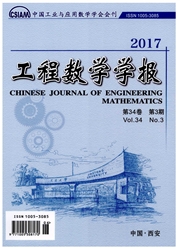

 中文摘要:
中文摘要:
日本血吸虫病是在我国广为流传的传染病和寄生虫病,对人体的健康造成了极其严重的危害,关于日本血吸虫病的传播动力学模型引起了广泛的讨论。在吴建宏等建立的双宿主日本血吸虫病的自治动力学模型的基础上,考虑到湖泊型地区钉螺数量的季节性变化因素,本文考察了相应的非自治的传播动力学模型,研究了其周期解的稳定性,并在此基础上进行了数值模拟。研究表明,在一定的参数条件下,无论开始时疾病传播情况如何,疾病终将趋于消亡;否则,在一定的初始条件下,疾病传播形成周期性的地方病。数值模拟发现,在一定的参数条件下,钉螺数量的季节性变化振幅充分大时,可使疾病趋于消亡;此外,同时对患病的人与牛进行治疗,也有利于使疾病消亡。本文中还研究了Barbour双宿主模型的非自治动力学模型,不仅对其周期解的稳定性进行了讨论,还得到该系统周期解的存在性条件。
 英文摘要:
英文摘要:
Japonicum is a widely spread infectious disease in China that has been jeopardizing human health for a long time. Numerous dynamic models were built up to study the mechanism of its transmission. Wu have proposed an autonomous dual-host model for the transmission dynamics of the schistosomiasis japonicum. In this paper, based on their model, a corresponding non-autonomous transmission model for the lake type districts is considered by accounting for the seasonal variation of snails numbers. The asymptotic stability of periodic solutions is studied and a numerical simulation is carried out for further illustrations. The result shows that, with certain parameters, the disease will vanish eventually regardless of the original condition; otherwise, under certain initial condition,it will develop into periodic endemic disease. It also shows that, with certain parameters, when theswing of periodical variation of snails aggregates to a certain number, the disease will disappear; and,curing the infected cow and people at the same time is more effective for disease control. On the other hand, the non-autonomous situation of Barbour dual-host model is studied and the existence conditions for positive periodic solutions is given based on the study of the asymptotic stability of its periodic solutions.
 同期刊论文项目
同期刊论文项目
 同项目期刊论文
同项目期刊论文
 The dynamics of spreading and immune strategies of sexually transmitted diseases on scale-free netwo
The dynamics of spreading and immune strategies of sexually transmitted diseases on scale-free netwo Permanence and stability in multi-species non-autonomous Lotka-Volterra competitive systems with del
Permanence and stability in multi-species non-autonomous Lotka-Volterra competitive systems with del Local linear estimation of spatially varying coefficient models: an improvement on the geographicall
Local linear estimation of spatially varying coefficient models: an improvement on the geographicall 期刊信息
期刊信息
